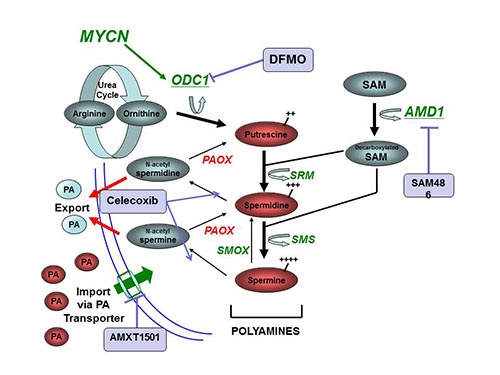


Posted February 25, 2015
Michael D. Hogarty, M.D., Children's Hospital of Philadelphia
Neuroblastoma (NB) is a lethal childhood cancer. Current treatments for high-risk cases include chemotherapy, surgery, radiation therapy, hematopoietic stem cell transplantation, differentiation therapy, and immunotherapy; however, even with these interventions, survival rates are still poor. With a fiscal year 2009 Investigator-Initiated Research Award from the Peer Reviewed Medical Research Program, Dr. Michael Hogarty, at Children's Hospital of Philadelphia, studied the use of drugs that block polyamines - a family of organic compounds - as a key element in the fight against neuroblastoma.
The proteins c-MYC and MYCN are regulators of metabolic activity and of the construction of cellular components and are often upregulated in neuroblastomas and other types of cancer. There have been many attempts in the past to target c-MYC or MYCN upregulation in neuroblastoma and other cancers but these have met with little success. Polyamines, which are required for life, are made inside living cells and also imported from cells' surroundings. Dr. Hogarty noticed that, in many neuroblastomas, the cellular machinery that controls polyamine availability is overactive, and nearly every enzyme controlling this machinery is regulated by c-MYC or MYCN. He reasoned that, instead of targeting elevated c-MYC or MYCN, he might be able to attack the elevated availability of polyamines that arises as a consequence of elevated c-MYC or MYCN and allows for rapid growth.
Dr. Hogarty hypothesized that using one drug to target polyamines might be insufficient. For example, a neuroblastoma cell might grow despite blocked polyamine production by importing more polyamines from its surroundings instead. Therefore, Dr. Hogarty hypothesized that a multi-pronged approach to target different aspects of cellular polyamine production and utilization would be more effective than treatment with a single agent.
Dr. Hogarty tested four polyamine-targeting drugs alone and in different combinations. He tested these in mice with a genetic predisposition to develop neuroblastomas, in cell cultures derived from experimental neuroblastomas, and human neuroblastomas transplanted into mice. Two of the drugs Dr. Hogarty tested are already FDA-approved (though not for neuroblastoma treatment): DFMO, the blocker of polyamine production, and Celecoxib, which indirectly enhances the expulsion of polyamines from cells. These were combined with the experimental drugs SAM486, which prevents the inter-conversion of different types of polyamines within cells, and AMXT1501, which prevents the import of external polyamines. Another important aspect of the project was to test these polyamine-targeting agents in combination with chemotherapeutic agents to determine whether the experimental treatments would have any effect (good or bad) on the efficacy of conventional tumor treatments.
The results from this study gave credence to utility of the multi-pronged combination therapy over the use of single agents. While single agents were generally somewhat effective in one or two types of experimental neuroblastoma, combinations generally proved more effective in individual measures and more broadly effective across various measures including slowing or halting established disease and disease prevention in genetically prone mice. Importantly, treatment using polyamine-targeting drugs in combination with conventional chemotherapy showed synergistic rather than conflicting effects.
This work led directly to a Phase 1 trial using DFMO and Celecoxib together with the chemotherapy agents Cyclophosphomide and Topotecan in children with relapsed neuroblastoma. The trial is presently recruiting subjects (http://clinicaltrials.gov/show/NCT02030964). In addition, further data is being collected on potency of the promising AMXT1501 molecule in combination with DFMO and other compounds in anticipation of future clinical trials.

Links:














